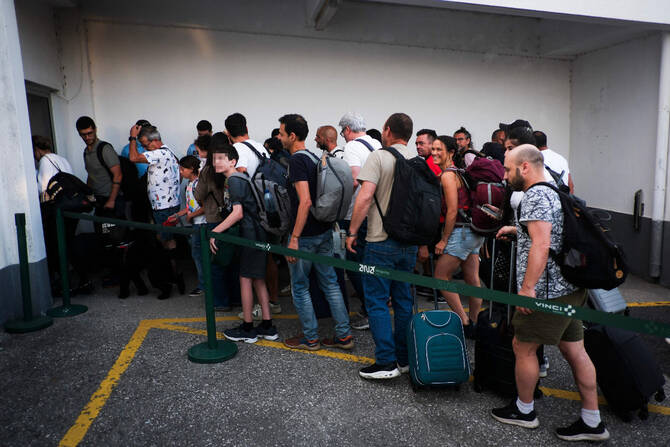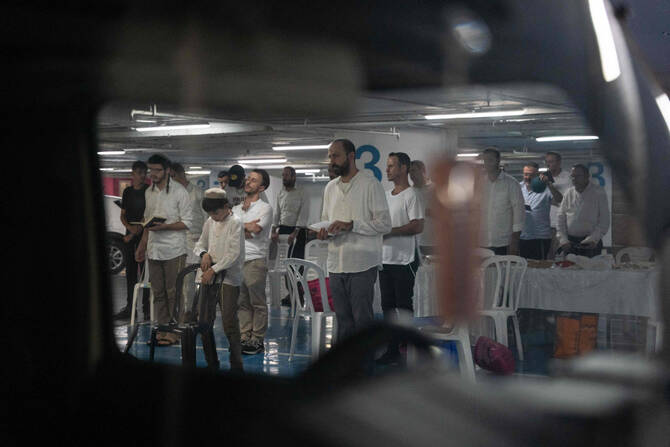TEL AVIV: Israel ‘s military said Saturday it was preparing for the possibility of a lengthy war, while Iran’s foreign minister warned that US military involvement “would be very, very dangerous for everyone.”
The prospect of a wider war threatened, too. Iranian-backed Houthi rebels in Yemen said they would resume attacks on US vessels in the Red Sea if the Trump administration joins Israel’s military campaign. The Houthis paused such attacks in May under a deal with the United States.
The US ambassador to Israel announced the US has begun “assisted departure flights,” the first from Israel since the Hamas-led attack on Oct. 7, 2023, that sparked the war in Gaza.
Israel’s military said it struck an Iranian nuclear research facility overnight and killed three senior Iranian commanders in pursuit of its goal to destroy Iran’s nuclear program. Smoke rose near a mountain in Isfahan, where the province’s deputy governor for security affairs, Akbar Salehi, confirmed Israeli strikes damaged the facility.
The target was a centrifuge production site, Israel’s military said. The International Atomic Energy Agency confirmed the attack and said the facility — also targeted in the war’s first day — was “extensively damaged,” but that there was no risk of off-site contamination.
Iran again launched drones and missiles at Israel but there were no reports of significant damage. An Israeli military official, speaking on condition of anonymity under army guidelines, estimated the military has taken out more than 50 percent of Iran’s launchers.
“We’re making it harder for them to fire toward Israel,” he said.
The Israeli military’s chief spokesman, Brig. Gen. Effie Defrin, later said Chief of Staff Lt. Gen. Eyal Zamir told the army to prepare for a “prolonged campaign.”
US aerial refueling tankers on the move
US President Donald Trump is weighing active US military involvement in the war, and was set to meet with his national security team Saturday evening. He has said he would put off his decision for up to two weeks.
Iranian Foreign Minister Abbas Araghchi said US military involvement “would be very, very dangerous for everyone.” He spoke on the sidelines of an Organization of Islamic Cooperation meeting in Turkiye. Araghchi was open to further dialogue but emphasized that Iran had no interest in negotiating with the US while Israel continues to attack.
Barring a commando raid or even a nuclear strike, Iran’s underground Fordo uranium enrichment facility is considered out of reach to all but America’s “bunker-buster” bombs. The US has only configured and programmed its B-2 Spirit stealth bomber to deliver the bomb, according to the Air Force.
On Saturday, multiple US aerial refueling tankers were spotted on commercial flight trackers flying patterns consistent with escorting aircraft from the central US to the Pacific. B-2 bombers are based in Missouri. It was not clear whether the aircraft were a show of force or prepared for an operation. The White House and Pentagon did not respond to requests for comment.
The war’s toll
The war erupted June 13, with Israeli airstrikes targeting Iran’s nuclear and military sites, top generals and nuclear scientists. At least 722 people, including 285 civilians, have been killed in Iran and more than 2,500 wounded, according to a Washington-based Iranian human rights group.
One Tehran resident, Nasrin, writhed in her hospital bed as she described how a blast threw her against her apartment wall. “I’ve had five surgeries. I think I have nothing right here that is intact,” she said Saturday. Another patient, Shahram Nourmohammadi, said he had been making deliveries when “something blew up right in front of me.”
Several Iranians have fled the country. “Everyone is leaving Tehran right now,” said one who did not give his name after crossing into Armenia.
For many Iranians, it is difficult to know what’s going on. Internet-access advocacy group NetBlocks.org said Saturday that limited Internet access had again “collapsed.” A nationwide Internet shutdown has lasted for several days.
Iran has retaliated by firing more than 450 missiles and 1,000 drones at Israel, according to Israeli army estimates. Israel’s multitiered air defenses have shot down most of them, but at least 24 people in Israel have been killed and over 1,000 wounded.
No date has been set for more talks after negotiations in Geneva failed to produce a breakthrough Friday.
Iran’s nuclear program
Iran has long maintained its nuclear program is for peaceful purposes, but it is the only non-nuclear-weapon state to enrich uranium up to 60 percent — a short, technical step away from weapons-grade levels of 90 percent. Israel is widely believed to be the only Middle Eastern country with a nuclear weapons program but has never acknowledged it.
Israeli Prime Minister Benjamin Netanyahu has said Israel’s military operation will continue “for as long as it takes” to eliminate what he called the existential threat of Iran’s nuclear program and ballistic missile arsenal.
Iranian President Masoud Pezeshkian said Saturday that his country will never renounce its right to nuclear power, which “cannot be taken away from it through war and threats.” Pezeshkian told French President Emmanuel Macron via phone that Iran is ready to provide guarantees and confidence-building measures to demonstrate the peaceful nature of its nuclear activities, according to IRNA, the state-run news agency.
Iran previously agreed to limit its uranium enrichment and allow international inspectors access to its nuclear sites under a 2015 deal in exchange for sanctions relief. But after Trump pulled the US out of the deal during his first term, Iran began enriching uranium up to 60 percent and restricting access to its nuclear facilities.
Iran has insisted on its right to enrich uranium — at lower levels — in recent talks over its nuclear program. But Trump, like Israel, has demanded Iran end its enrichment program altogether.
Attacks on Iranian military commanders
Israel’s defense minister said the military killed a paramilitary Revolutionary Guard commander who financed and armed Hamas in preparation for the Oct. 7 attack on Israel.
Iranian officials did not immediately confirm Saeed Izadi’s death, but the Qom governor’s office said a four-story apartment building was hit and local media reported two people had been killed.
Israel also said it killed the commander of the Quds Force’s weapons transfer unit, who it said was responsible for providing weapons to Hezbollah and Hamas. Behnam Shahriyari was killed while traveling in western Iran, the military said.
Iran threatens head of UN nuclear watchdog
Iranian leaders say IAEA chief Rafael Grossi’s statements about the status of Iran’s nuclear program prompted Israel’s attack. On Saturday, a senior adviser for Iran’s Supreme Leader Ali Khamanei, Ali Larijani, said on social media, without elaboration, that Iran would make Grossi “pay” once the war is over.
Grossi on Friday warned against attacks on Iran’s nuclear reactors, particularly its only commercial nuclear power plant in the southern city of Bushehr. A direct hit “would result in a very high release of radioactivity,” Grossi said, adding: “This is the nuclear site in Iran where the consequences could be most serious.”
Israel has not targeted Iran’s nuclear reactors, instead focusing on the main uranium enrichment facility at Natanz, centrifuge workshops near Tehran, laboratories in Isfahan and the country’s Arak heavy water reactor southwest of the capital.
Israel says it’s preparing for the possibility of a lengthy war against Iran
https://arab.news/57wvy
Israel says it’s preparing for the possibility of a lengthy war against Iran

- Iran FM says Tehran open to further dialogue but no interest in talks with US while Israel continues to attack
- Netanyahu has said Israeli operation will continue until it eliminates the threat of Iran’s nuclear program
Sudan’s prime minister takes his peace plan to the UN, but US urges humanitarian truce now

- Sudan’s prime minister is proposing a wide-ranging peace initiative to end a nearly 1,000-day war with a rival paramilitary force
- It seems unlikely the RSF would support the proposal, which would essentially give government forces a victory and take away their military power
UNITED NATIONS: Sudan’s prime minister on Monday proposed a wide-ranging peace initiative to end a nearly 1,000-day war with a rival paramilitary force, but the United States urged both sides to accept the Trump administration’s call for an immediate humanitarian truce.
Kamil Idris, who heads Sudan’s transitional civilian government, told the Security Council his plan calls for a ceasefire monitored by the United Nations, African Union and Arab League, and the withdrawal of paramilitary forces from all areas they occupy, their placement in supervised camps and their disarmament.
Sudan plunged into chaos in April 2023 when a power struggle between the military and the powerful paramilitary Rapid Support Forces exploded into open fighting, with widespread mass killings and rapes, and ethnically motivated violence. This has amounted to war crimes and crimes against humanity, according to the UN and international rights groups.
It seemed highly unlikely the RSF would support the prime minister’s proposal, which would essentially give government forces a victory and take away their military power.
In an indirect reference to the truce supported by the US and key mediators Saudi Arabia, Egypt and the United Arab Emirates, known as the Quad, Idris stressed to the UN Security Council that the government’s proposal is “homemade — not imposed on us.”
In early November, the Rapid Support Forces agreed to a humanitarian truce. At that time, a Sudanese military official told The Associated Press the army welcomed the Quad’s proposal but would only agree to a truce when the RSF completely withdraws from civilian areas and gives up their weapons — key provisions in the plan Idris put forward on Monday.
Idris said unless the paramilitary forces were confined to camps, a truce had “no chance for success.” He challenged the 15 members of the Security Council to back his proposal.
“This initiative can mark the moment when Sudan steps back from the edge and the international community — You! You! — stood on the right side of history,” the Sudanese prime minister said. He said the council should “be remembered not as a witness to collapse, but as a partner in recovery.”
US deputy ambassador Jeffrey Bartos, who spoke to the council before Idris, said the Trump administration has offered a humanitarian truce as a way forward and “We urge both belligerents to accept this plan without preconditions immediately.”
Bartos said the Trump administration strongly condemns the horrific violence across Darfur and the Kordofan region — and the atrocities committed by both the Sudanese Armed Forces and the Rapid Support Forces, who must be held accountable.
UAE Ambassador Mohamed Abushahab, a member of the Quad, said there is an immediate opportunity to implement the humanitarian truce and get aid to Sudanese civilians in desperate need.
“Lessons of history and present realities make it clear that unilateral efforts by either of the warring parties are not sustainable and will only prolong the war,” he warned.
Abushahab said a humanitarian truce must be followed by a permanent ceasefire “and a pathway toward civilian rule independent of the warring parties.”
UN Assistant Secretary-General for political affairs Khaled Khiari reflected escalating council concerns about the Sudan war, which has been fueled by the continuing supply of increasingly sophisticated weapons.
He criticized unnamed countries that refuse to stop supplying weapons, and both government and paramilitary forces for remaining unwilling to compromise or de-escalate.
“While they were able to stop fighting to preserve oil revenues, they have so far failed to do the same to protect their population,” Khiari said. “The backers of both sides must use their influence to help stop the slaughter, not to cause further devastation.”
The devastating war in Sudan has killed more than 40,000 people according to UN figures, but aid groups say the true number could be many times higher. The conflict has created the world’s largest humanitarian crisis, with over 14 million people displaced, disease outbreaks and famine spreading in parts of the country.















